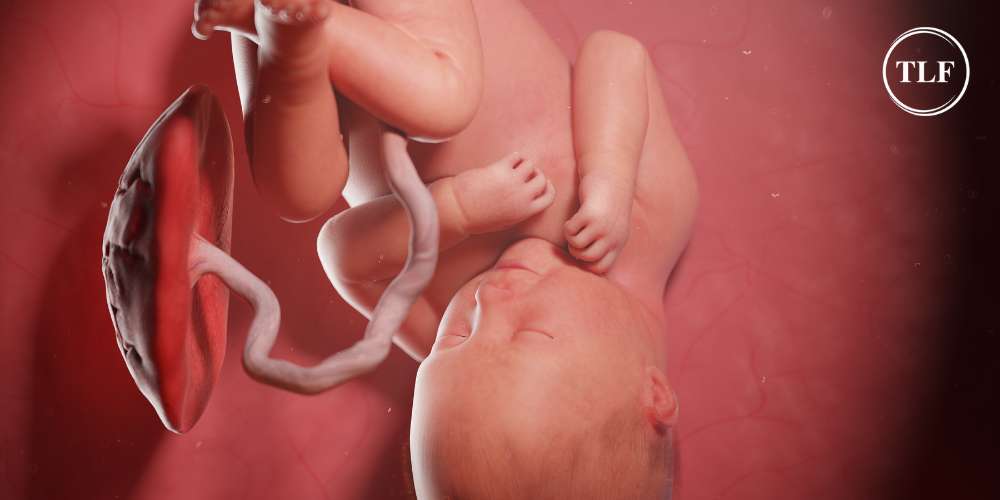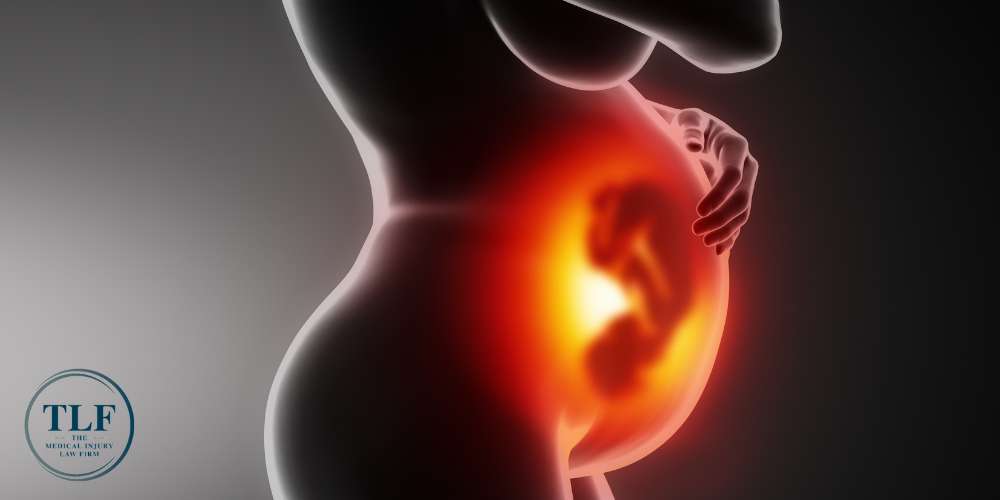Umbilical cord abnormalities can significantly impact a pregnancy. This includes cases of compressed umbilical cords, prolapsed umbilical cords, cord knots, umbilical cord thrombosis, and marginal cord insertion, among others. Problems with the umbilical cord, including marginal cord insertions, can lead to adverse perinatal outcomes such as premature birth and miscarriages.
At TLF: The Medical Injury Law Firm, our Northern Kentucky and Ohio birth injury lawyers understand the profound implications these complications can have on families. In this blog, we aim to shed some light on the condition of Marginal Umbilical Cord Insertion, including its potential causes, risks, and how our experienced legal team can help families affected by umbilical cord-related birth injuries caused by medical negligence.
What is Marginal Cord Insertion?
In a normal pregnancy, the umbilical cord attaches to the center of the placenta, a process known as central cord insertion. When the insertion of the umbilical cord is abnormal, it poses serious risks for the developing fetus and its mother. One of these abnormalities is called marginal placental cord insertion.
Marginal cord insertion, sometimes also referred to as eccentric cord insertion, occurs when the umbilical cord attaches to the edge of the placenta rather than its center. This abnormal attachment can lead to various complications, as the marginal placement may result in less efficient nutrient and oxygen transfer to the fetus.

How Common is Marginal Cord Insertion?
Marginal cord insertions are not very common, but they are not necessarily rare either. According to the Cleveland Clinic, marginal umbilical cord insertion can occur in anywhere from 2% to 25% of pregnancies, with singleton births (one child) being less likely than multiple births (twins, triplets, etc.).
Is Marginal Cord Insertion Dangerous?
Marginal cord insertion can be dangerous, as it is associated with a number of potential complications during pregnancy and labor. One of the most significant concerns regarding marginal insertion is restricted blood flow and nutrient supply to the baby, which can result in fetal growth restriction, preterm labor, a low birth weight, and in some cases, miscarriages.
Marginal cord insertion also increases the risk of placental abruption as well as a number of other dangerous pregnancy complications.
Velamentous Cord Insertion vs. Marginal Cord Insertion
Marginal cord insertion and velamentous cord insertion are both types of abnormal cord insertion, but they differ in a few key ways. In marginal cord insertion, the umbilical cord attaches to the edge of the placenta rather than the center, whereas in velamentous cord insertion, the blood vessels of the umbilical cord attach to the amniotic sac rather than attach to the placenta at all.
Velamentous cord insertions are typically a greater cause for concern than marginal insertions because the exposed vessels are not protected, making them vulnerable to rupture. As such, velamentous insertion is associated with a higher risk of a condition called vasa previa, which can lead to excessive bleeding during delivery, putting both the mother and baby at risk. Like marginal insertions, however, it can also lead to complications such as restricted fetal growth, preterm birth, and fetal distress due to compromised blood flow.
Both conditions require careful monitoring and management by healthcare providers to mitigate risks and ensure the health and safety of both mother and baby.

Signs and Symptoms of Marginal Umbilical Cord Insertion
Typically, marginal cord insertion itself does not present easily recognizable signs or symptoms for pregnant women. It is most easily and commonly detected with a prenatal ultrasound. However, there are certain signs to look out for that may be associated with complications arising from this condition, including:
- Reduced fetal growth
- Decreased fetal movement
- Abnormal fundal height (measurement from the pubic bone to the top of the uterus)
- Low amount of amniotic fluid (oligohydramnios)
- Abnormal blood flow patterns in the umbilical cord
- Preterm labor
The National Library of Medicine published findings that suggest that placental and umbilical cord developmental abnormalities often occur when the cord attaches to the lower third of the uterus during the first trimester, marginal cord insertion being one of these. As such, it is suggested that umbilical cord insertion site screening between 9-11 weeks of gestation is extremely helpful in predicting and preparing for potential cord and placenta abnormalities in the later stages of pregnancy.
What Causes Marginal Cord Insertion?
The causes of abnormal insertion of an umbilical cord are not well understood other than the fact that they result from abnormal placental development during early pregnancy. However, many medical professionals believe that marginal cord insertion is associated with a few specific risk factors, including:
- Older maternal age
- Maternal health conditions, such as hypertension and diabetes
- Multiple pregnancies
- The use of fertility treatments (IVF)
- Previous placental issues
- Certain lifestyle factors, such as smoking and substance abuse
It’s important to note that while these factors may contribute to the risk, marginal cord insertion can occur in any pregnancy without any identifiable cause. This is why regular prenatal care and ultrasound monitoring are absolutely critical for early detection and management of this condition.

Can Marginal Cord Insertion Correct Itself?
Marginal cord insertion typically does not correct itself as the pregnancy progresses. Once the umbilical cord attaches to the edge of the placenta, it remains in that position throughout the pregnancy. However, with careful monitoring, more frequent ultrasounds, and appropriate medical care, many pregnancies with marginal cord insertion can still result in healthy outcomes.
Does Marginal Cord Insertion Require C-Section?
Pregnancies with marginal umbilical cord insertion do not automatically require a cesarean section (C-section delivery). Many women with this condition can still have a successful vaginal delivery. However, the presence of marginal cord insertion does warrant closer monitoring throughout pregnancy to watch for potential complications such as restricted fetal growth or distress. If any significant issues arise that pose risks to the mother or baby, a healthcare provider may recommend a cesarean delivery to ensure the health and safety of both.
Can Marginal Cord Insertion Cause Birth Defects?
Marginal cord insertions are not directly associated with birth defects, but they can lead to complications that may affect fetal development. For example, the primary concerns with marginal cord insertion are related to restricted blood flow and nutrient supply to the fetus, which can result in intrauterine growth restriction (IUGR). This growth restriction can potentially lead to abnormal development and various health issues for the baby.
Marginal Cord Insertion Risks
In addition to preterm delivery, the restricted growth of the fetus, and potential miscarriages or stillbirth, marginal cord insertion can lead to a number of other potential risks during pregnancy, including:
- Placental Abruption: A placental abruption occurs when the placenta detaches from the uterine wall prematurely, which can cause significant complications for both the mother and the baby.
- Placenta Previa: Placenta previa occurs when the placenta partially or completely covers the birth canal, leading to an increased risk of postpartum hemorrhage and potentially fatal outcomes.
- Excessive Bleeding: Marginal cord insertion can lead to excessive vaginal bleeding during labor and delivery.
- Fetal Distress: The compromised blood flow and nutrient supply associated with marginal cord insertion can lead to fetal distress.

Can You File a Birth Injury Claim for Marginal Cord Insertion?
Filing a birth injury claim for marginal cord insertion or other abnormal cord insertions is possible under certain circumstances. To have a valid claim, it must be demonstrated that medical negligence or improper management of the condition by healthcare providers directly led to adverse outcomes such as harm or injury to the mother and/or baby.
To do this, the following elements of medical negligence must be proven:
- Duty of Care: The healthcare provider owed a duty of care to the patient.
- Breach of Duty: The provider breached this duty by failing to adhere to the standard of care, whether through action or omission.
- Causation: The breach of duty directly caused harm or injury to the mother or baby.
- Damages: The patient(s) suffered actual harm or damages, which can include physical injury, emotional distress, additional medical expenses, and lost wages.
Proving these elements typically requires thorough documentation, medical records, and expert witness testimony to substantiate that the healthcare provider’s actions deviated from standard medical practices and led to adverse outcomes.
When Medical Negligence Plays a Role
We place our trust in medical professionals to take care of us, especially when it comes to seeing a pregnancy through to a healthy delivery. Unfortunately, that is not always the case. Medical negligence can occur in a number of different ways, including:
- Failure to Diagnose: If healthcare providers did not identify the marginal cord insertion during routine prenatal care, ultrasound examinations, or other diagnostic tests.
- Improper Monitoring: If there was inadequate monitoring and management of the condition leading to maternal/fetal health complications.
- Failure to Act on Complications: If medical professionals failed to take appropriate action when complications arose, such as not performing a necessary C-section delivery.
- Substandard Care: If the care provided fell below the accepted medical standards and directly resulted in adverse outcomes.
If you believe that medical negligence played a role in you or your child’s injuries or death, consulting with an experienced medical malpractice attorney at TLF can help you understand your legal options moving forward.
How the Kentucky and Ohio Birth Injury Attorneys at TLF Can Help
At TLF: The Medical Injury Law Firm, our attorneys are dedicated to helping families who have experienced harm due to preventable birth injuries, including those arising from marginal cord insertion complications. With extensive experience in medical malpractice and birth injury cases across both Kentucky and Ohio, our skilled legal team understands the many challenges involved in such a situation and is committed to advocating for the rights of those affected.
With every case we take on, our goal is to secure the compensation our clients deserve for the physical, emotional, and financial burdens they face due to the hands of negligent medical professionals. Trust the dedicated birth injury attorneys at TLF to guide you through this difficult time and fight for justice on your behalf.

Call TLF: The Medical Injury Law Firm for a Free Consultation Regarding Your Case
If you or a loved one has been affected by a preventable birth injury in Northern Kentucky or the Cincinnati, OH area, do not hesitate to seek the help of an experienced and compassionate medical malpractice attorney at TLF: The Medical Injury Law Firm. We are ready to help you navigate this difficult time and hold negligent healthcare providers accountable for their actions.
To get in touch with a member of our legal team, simply call our toll-free number at (800) 698-4054 today. You can also reach our Ohio office directly at (513) 651-4130, our Kentucky office at (859) 578-9130, or contact us via our online intake form.

